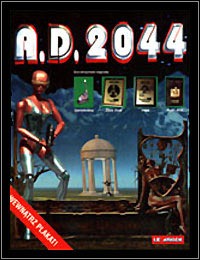Software:A.D. 2044
| A.D. 2044 | |
|---|---|
 | |
| Developer(s) | LK Avalon |
| Publisher(s) | LK Avalon |
| Release | September 9, 1996 |
| Genre(s) | Adventure |
A.D. 2044 is a Polish adventure game by LK Avalon, released September 9, 1996 on Windows.
Production
The game is a remake of a 1991 game of the same name developed by R.M.P. Software and published by LK Avalon, released to Atari 8-bit computers. It was a simple point and click adventure game created by Roland Pantoła. The new game is based on the same narrative, but with updated graphics.[1]
It was the first Polish computer game released on two CDs and to have rendered three-dimensional graphics.[2] The game was accompanied by a promotion in mass media that was unprecedented in scale for the country.[3] While the game was originally released in Polish, English subtitles were finally added to the game in 2017.[4]
Plot and gameplay
Based on the film Seksmisja by Juliusz Machulski, the game is set in a future post-apocalyptic world where women rule the planet. This is caused by a radical women's group who capture some nuclear weapons and demand equal power from men, who respond by sending missiles which causes a nuclear winter. A thousand women survive by being in an underground bunker. In 2044, they discover a single male who was preserved in a hibernation capsule. The player is this male who escapes capture and begins to explore the environment.
The game plays like a point and click adventure. Players collect and manipulate items and click on hotspots. A male voice narrates the story and also provides hints.
Critical reception
Gra.pl felt the 1991 version should be treated as a mere "interesting curiosity" in comparison to the more "interesting and better developed" one from 1996.[5]
Metzomagic noted the game window was more generous that in other games, reaching around two-thirds of the screen.[6] Imperium Gier felt that while the game was once considered very good, by the standards of 2012 it is simply average. However, the reviewer also noted that the game was a milestone in the Polish video game industry.[1] Gry Online thought the game's visual design was its draw card.[2]
References
- ↑ 1.0 1.1 "A.D. 2044 - Recenzja - Imperium gier - WP.PL". 9 July 2012. Archived from the original on 9 July 2012. https://archive.today/20120709110736/http://gry.wp.pl/recenzja/a-d-2044,1601,1.html.
- ↑ 2.0 2.1 "A.D. 2044 (PC) - GRYOnline.pl". https://www.gry-online.pl/s016.asp?id=653.
- ↑ "A.D. 2044 - Recenzja - Imperium gier - WP.PL". 9 July 2012. Archived from the original on 9 July 2012. https://archive.today/20120709110736/http://gry.wp.pl/recenzja/a-d-2044,1601,1.html.
- ↑ "A.D. 2044 Adventure Game Information, Reviews, Screenshots & Videos". https://adventuregamers.com/games/view/33863.
- ↑ "Historia Polskich Gier: A.D. 2044". http://www.gra.pl/gry/historia-polskich-gier-ad-2044.
- ↑ "A.D. 2044 Review by metzomagic.com". http://www.metzomagic.com/showArticle.php?index=588.
 |

